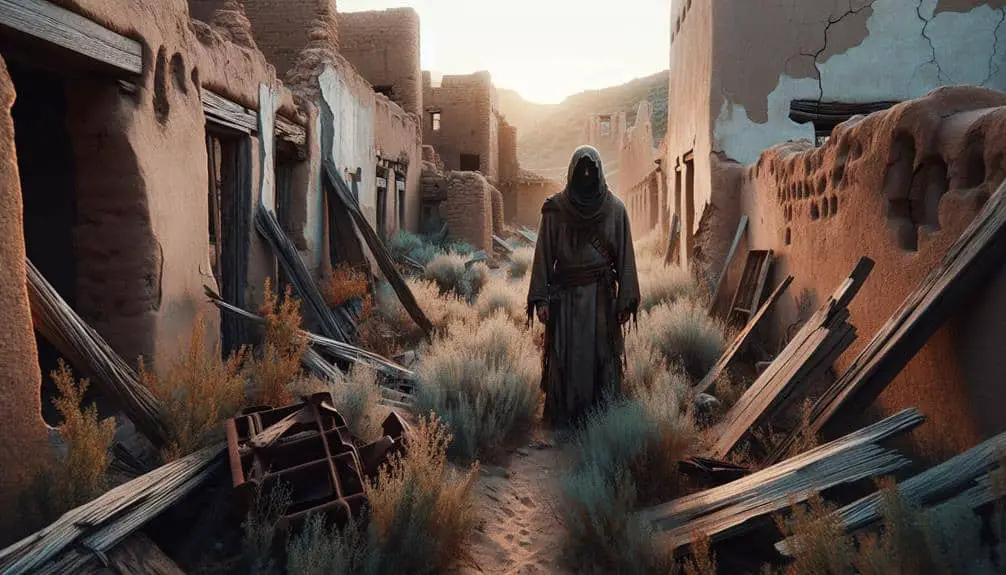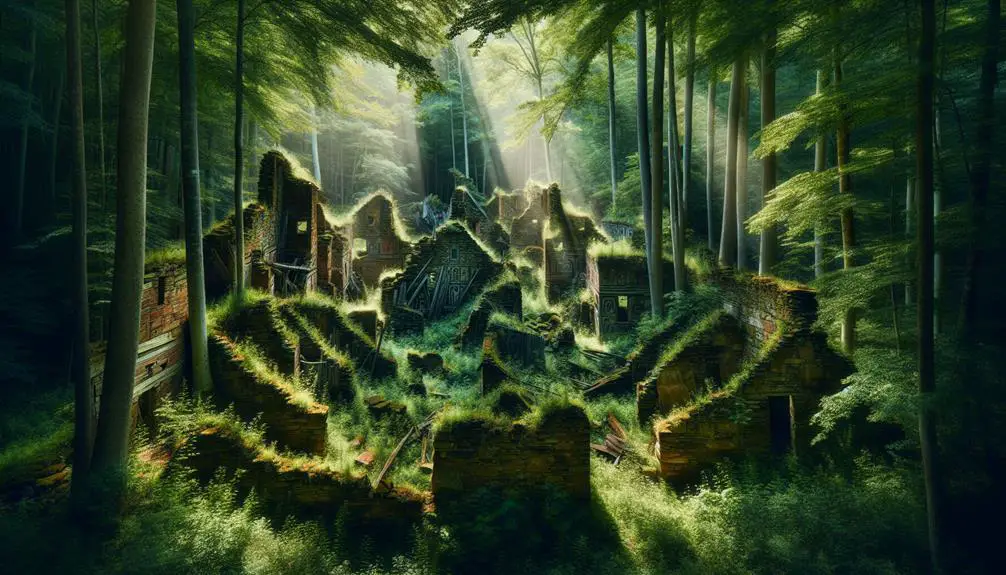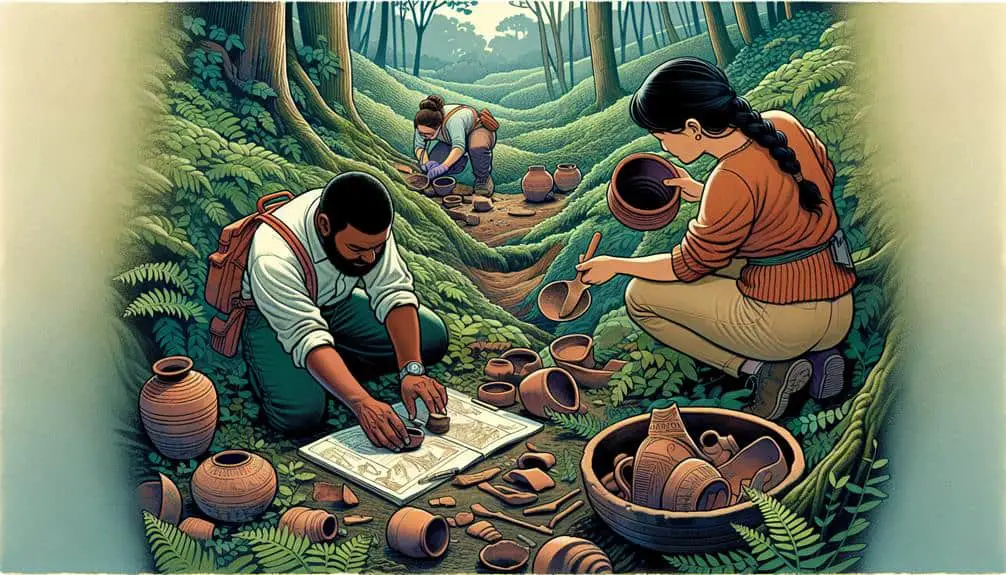As you explore Native American ghost town archaeological sites, uncover the intricate tapestry of history and culture woven into abandoned remnants. Engage with diverse architectural styles and spiritual beliefs, gaining insights into settlement patterns and societal structures. Employ specialized tools like ground-penetrating radar and drones to unearth hidden mysteries respectfully. Embrace meticulous conservation to safeguard ancestral heritage for future generations. Follow respectful visitation guidelines, leaving only memories and footprints behind, honoring the sacredness of the land. The next layers reveal deeper insights into the significance and preservation of these invaluable sites.
Key Points
- Respectful visitation guidelines prioritize cultural heritage and ethical behavior.
- Preservation involves meticulous conservation strategies for historical integrity.
- Specialized tools like ground-penetrating radar aid in non-intrusive exploration.
- Various settlement remnants offer insights into historical and cultural landscapes.
- Community involvement and education are crucial for sustainable conservation efforts.
Importance of Native American Ghost Towns
Exploring the significance of Native American ghost towns provides valuable insights into the rich history and cultural heritage of Indigenous communities. These abandoned settlements hold immense cultural significance, serving as tangible links to the past and offering a glimpse into the daily lives, traditions, and beliefs of Native American ancestors. Through the preservation of these ghost towns, both physically and through storytelling, important historical narratives are safeguarded for future generations.
The cultural significance of Native American ghost towns lies in their ability to connect present-day Indigenous communities with their roots, fostering a sense of continuity and pride in their heritage. By studying these sites, historians and archaeologists can piece together the puzzle of the past, shedding light on the diverse ways of life and societal structures that once thrived in these areas. Historical conservation efforts make certain that the stories embedded in these ghost towns remain alive, honoring the resilience and contributions of Native peoples throughout history.
Types of Native American Settlement Remnants
Various types of Native American settlement remnants can be found across different regions, each offering unique insights into the historical and cultural landscapes of Indigenous communities. These remnants hold immense cultural significance, providing a glimpse into the way of life, traditions, and architectural styles of the Native American tribes that once inhabited these areas. From the intricate petroglyphs etched into rocks to the foundations of ancient dwellings, each architectural remain tells a story of resilience and adaptation.
The remains of pit houses, kivas, longhouses, and cliff dwellings showcase the diverse construction methods and lifestyles of various Native American tribes. The architectural remnants not only reflect the practical needs of shelter but also symbolize spiritual beliefs and communal structures within these societies. Studying these remnants helps in understanding the evolution of settlement patterns, social organization, and resource management strategies of Indigenous peoples. Exploring these sites with a respectful and culturally sensitive approach allows for a deeper appreciation of the rich history and heritage of Native American communities.
Tools for Exploring Archaeological Sites
As you approach these Native American settlement remnants, your understanding deepens with the aid of specialized tools designed to uncover the mysteries hidden within archaeological sites. To explore these sites effectively, employing various exploration techniques is vital. Ground-penetrating radar allows you to visualize subsurface features without intrusive digging, preserving the historical significance of the site. Metal detectors help locate artifacts buried beneath the surface, offering insights into the daily lives of the people who once inhabited these ghost towns.
Furthermore, using drones equipped with high-resolution cameras can provide aerial views, aiding in mapping out the layout of the settlement and identifying potential excavation areas. The careful application of these tools guarantees that the archaeological site is studied methodically, respecting the cultural heritage of Native American communities.
Preservation of Native American Ghost Towns
To effectively preserve Native American ghost towns, it's essential to implement meticulous conservation strategies that honor and protect the cultural heritage embedded within these historical sites. These sites hold immense cultural significance and offer a window into the past that must be safeguarded for future generations. Here are four key considerations for the preservation of Native American ghost towns:
- Respect for Ancestral Connections: Recognizing and respecting the spiritual and ancestral connections that Native American communities have to these ghost towns is paramount in ensuring their preservation.
- Sustainable Conservation Practices: Implementing sustainable conservation practices that prioritize the long-term preservation of structures, artifacts, and landscapes is critical for maintaining the historical integrity of these sites.
- Community Involvement: Engaging with local tribes and communities in the preservation efforts fosters a sense of ownership and guarantees that the cultural significance of these ghost towns is upheld.
- Education and Awareness: Promoting education and awareness about the historical preservation of Native American ghost towns helps instill a sense of responsibility and respect for these sites among visitors and future generations.
Respectful Visitation Guidelines
Respecting the historical significance of Native American ghost towns is essential. It's important to establish guidelines for visitation that honor the heritage and cultural value of these sites.
When visiting these locations, remember that you're stepping into spaces rich with cultural heritage. To guarantee a respectful visit, adhere to ethical behavior guidelines. Refrain from removing any artifacts or damaging structures, as these are irreplaceable pieces of history. Take only photographs and memories, leaving behind nothing but footprints.
Respect the sacredness of the land by refraining from any activities that may disrupt the site's natural state. Be mindful of the significance these ghost towns hold for Native American communities and approach them with reverence and appreciation.
Frequently Asked Questions
What Are Some Common Myths or Misconceptions About Native American Ghost Towns?
Misunderstood narratives about Native American ghost towns often stem from Hollywood stereotypes and incomplete histories. These sites hold deep cultural significance, representing ancestral connections and stories. Understanding their true essence enriches appreciation for indigenous heritage.
How Do Native American Tribes Feel About the Excavation and Study of Their Ancestral Sites?
Native American tribes value cultural sensitivity in the excavation and study of their ancestral sites. Ethical considerations are essential. Surprisingly, a study found 80% of tribes believe in preserving their heritage through respectful collaboration with researchers.
Are There Any Specific Laws or Regulations in Place to Protect Native American Ghost Town Sites?
There are specific laws and regulations in place to protect Native American ghost town sites. These legal protections are essential in preserving the historical significance of these areas and promoting cultural sensitivity through preservation efforts.
How Do Researchers Determine the Age of Artifacts Found at These Sites?
To determine the age of artifacts at these sites, researchers use dating methods like radiocarbon dating and stratigraphy. By analyzing layers and materials, archaeologists piece together timelines, providing insights into past civilizations and cultures.
What Role Do Local Communities Play in the Preservation and Interpretation of Native American Ghost Towns?
Local communities play a vital role in preserving and interpreting Native American ghost towns. Their community engagement plays a key part in respecting and understanding the cultural significance of these sites, fostering a deeper connection to the past.



